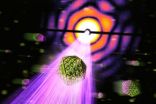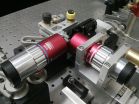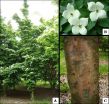(Press-News.org) An international team of scientists led by Uppsala University has developed a high-throughput method of imaging biological particles using an X-ray laser. The images show projections of the carboxysome particle, a delicate and tiny cell compartment in photosynthetic bacteria.
The experiment, described in a paper published today in the scientific journal Nature Photonics, represents a major milestone for studies of individual biological structures using X-ray lasers. The technique paves the way for 3D imaging of parts of the cell, and even small viruses, to develop a deeper understanding of life's smallest units.
To test the method, scientists from Uppsala University, the European XFEL, DESY and a number of other institutions used the carboxysome. The carboxysome is a cell organelle for CO2 assimilation in cyanobacteria that has been extensively studied in Uppsala by Dirk Hasse and Inger Andersson. Carboxysomes contain protein machinery that incorporates carbon from carbon dioxide into biomolecules. About a third of global carbon fixation happens in carboxysomes.
The carboxysome is a tiny structure -- only about 115 nanometres across, too small to clearly see with an optical microscope. A nanometre is a millionth of a millimetre.
Using a specially designed injector that produces a particle stream thinner than a human hair, the scientists sprayed an aerosol of carboxysomes across the beam of the LCLS X-ray laser at the SLAC National Accelerator Laboratory in the US. The scientists calculated the structure of the organelles by analysing the way the carboxysomes scatter the extremely short and ultra bright X-ray flashes of the LCLS. Up until now, this method required crystals of the sample material to get sufficient signal. Thanks to the extreme brightness of the X-ray laser and clever analysis of the diffraction patterns, the researchers could reconstruct individual samples without having to crystallise them. Carboxysomes like many other biological samples vary in shape and size and therefore cannot be crystallised.
Within 12 minutes, the researchers collected 70,000 scattering patterns from individual particles. The analysis returned an icosahedral shape (a structure with 20 triangle-shaped sides) for carboxysomes, in line with expectations. The results also showed considerable variation in size.
"Our method allows single-particle imaging of objects which can be different in size and shape", says Max Hantke, a doctoral student in molecular biophysics at Uppsala University in Sweden who led the research.
While electron microscopy usually requires samples to be frozen, X-ray lasers like the LCLS or the European XFEL, which is currently being built in Germany, can analyse biological samples without freezing. This method also offers the possibility to image whole living cells at unprecedented resolution.
"With the carboxysomes we have reconstructed the smallest single biological particles ever imaged with an X-ray laser, and we were also able to improve resolution. The reconstruction shows details as small as about 18 nanometres. For the first time we access a very interesting size regime with an X-ray laser. Large pathogenic viruses like HIV, influenza-, and herpes virus are in the same size domain as the carboxysome", says Max Hantke.
"These advances lay the foundations for accurate, high-throughput structure determination by flash-diffractive imaging and offer a means to study structure and structural heterogeneity in biology and elsewhere", says Professor Janos Hajdu, who is also one of the lead authors on the paper and one of Hantke's mentors as well as an advisor to European XFEL.
"Additionally, the size distribution of the carboxysomes before the experiment and what was seen in the resulting data matched almost perfectly", says Max Hantke, suggesting the organelles that were imaged were structurally intact.
While the intense X-ray pulse destroys the sample, an accurate diffraction pattern can be acquired before it disintegrates. This method, called "diffraction-before-destruction", was proposed in 2000 by the Uppsala group and was demonstrated with non-biological samples at DESY's FLASH facility in 2006.
Such single-particle imaging will be possible at the European XFEL when the facility opens to users in 2017. Two dedicated instruments will be available for such studies, the SPB instrument (Single Particles and Biomolecules) and the SFX instrument (Serial Femtosecond Crystallography), which will incorporate a similar sample injector to the one used in this experiment. With its 27,000 X-ray flashes per second and even higher intensity, the European XFEL will open up more opportunities and possibilities for researchers.
"In biology, there is heterogeneity at all levels, and we wanted a method for seeing it below the cellular level", says Janos Hajdu.
"We hope this research could lead to three-dimensional models showing the diversity of nanoscale cell parts", Max Hantke adds.
"These results show the way to high-throughput imaging of biological samples at high resolution. High data rates and very short exposures allow studies on the dynamics of particles and permit the analysis of structural variations, which are crucially important for life", says Filipe Maia, supervisor of Max Hantke.
INFORMATION:
For more information, please contact:
Max F. Hantke, Uppsala University, +46 18 471 4642 , hantke@xray.bmc.uu.se (http://lmb.icm.uu.se)
Dr. Dirk Hasse, Uppsala University, +46 18 471 4613, dirk.hasse@icm.uu.se
Dr. Filipe R. N. C. Maia, Uppsala University, +46 18 471 4642, filipe@xray.bmc.uu.se
Dr. Anton Barty, DESY, +49 40 8998-5783, anton.barty@desy.de
Prof. Inger Andersson, Uppsala University, +46 18 471 4288, inger@xray.bmc.uu.se
Prof. Janos Hajdu, Uppsala University and European XFEL, +46 18 471 4449, janos@xray.bmc.uu.se
Reference:
"High-throughput imaging of heterogeneous cell organelles with an X-ray laser"; Max F. Hantke, Dirk Hasse et al.; Nature Photonics, 2014; DOI: 10.1038/NPHOTON.2014.270
November 17, 2014 - A growing body of research evidence shows that complementary and alternative medicine (CAM) has health benefits for US military veterans and active duty personnel, according to a special December supplement to Medical Care. The journal is published by Lippincott Williams & Wilkins, a part of Wolters Kluwer Health.
The special issue presents new studies and commentaries on the benefits and increasing use of CAM techniques in the Veterans Health Administration (VHA) and other military health settings. "The papers in this supplement represent promising ...
Fatigue, increased irritability, and feeling demoralized, may raise a healthy man or woman's risk of first-time cardiovascular disease by 36 percent, according to a study led by researchers at Mount Sinai St. Luke's and Mount Sinai Roosevelt hospitals presented on Nov. 17 at the American Heart Association's Scientific Sessions 2014 in Chicago, IL.
The combination of fatigue, increased irritability, and feeling demoralized is medically known as vital exhaustion. In their study, Mount Sinai researchers found that vital exhaustion was associated with a dramatic increase ...
Fragile X syndrome (FXS) is the most common cause of inherited intellectual disability (ID), as well as the most frequent monogenic cause of autism spectrum disorders (ASD). FXS is caused by the absence or incorrect production of the protein FMRP (Fragile X Mental Retardation Protein). Scientists at VIB and KU Leuven (Belgium), in collaboration with Tor Vergata University (Italy) and VU University of Amsterdam (The Netherlands) have pinpointed a novel role that FMRP plays during the embryonic development of the brain cortex. The study reveals that the absence of FMRP leads ...
Researchers from the University of Southampton have developed a new technique to help produce more reliable and robust next generation photonic chips.
Photonic chips made from silicon will play a major role in future optical networks for worldwide data traffic. The high refractive index of silicon makes optical structures the size of a fraction of the diameter of a human hair possible. Squeezing more and more optical structures for light distribution, modulation, detection and routing into smaller chip areas allows for higher data rates at lower fabrication costs.
As ...
WASHINGTON, DC--Maritime traffic on the world's oceans has increased four-fold over the past 20 years, likely causing more water, air and noise pollution on the open seas, according to a new study quantifying global ship traffic.
The research used satellite data to estimate the number of vessels on the ocean every year between 1992 and 2012. The number of ships traversing the oceans grew by 60 percent between 1992 and 2002. Shipping traffic grew even faster during the second decade of the study, peaking at rate of increase of 10 percent per year in 2011.
Traffic went ...
We're entering the era of big neuroscience. In a little over a year, the United States, Europe, Japan and Israel have launched brain research projects with big budgets and bold ambitions. Several other countries are expected to follow suit. But what has propelled neuroscience to the vanguard, and what impact will these initiatives have on the field?
Leaders from three of these projects--the U.S. BRAIN Initiative, Europe's Human Brain Project and Japan's Brain/MINDS--discussed these and other questions ahead of this week's special session on global brain initiatives at ...
KNOXVILLE, TN -- In the nursery and landscape industries, flowering dogwood (Cornus florida), kousa dogwood (Cornus kousa), and their hybrids are the most popular and economically significant members of the genus Cornus. The deciduous trees are highly valued for their spring display of pink, red, or white bracts, brilliant red fall foliage, and exfoliating bark. In the United States alone, retail and wholesale sales of dogwoods account for more than $30 million dollars annually.
In the past, flowering dogwoods were severely affected by dogwood anthracnose and powdery ...
Cambridge, Mass. - November 17, 2014 - A vast majority of scientists believe that the Earth is warming at an unprecedented rate and that human activity is almost certainly the dominant cause. But on the topics of response and mitigation, there is far less consensus.
One of the most controversial propositions for slowing the increase in temperatures here on Earth is to manipulate the atmosphere above. Specifically, some scientists believe it should be possible to offset the warming effect of greenhouses gases by reflecting more of the sun's energy back into space.
The ...
This news release is available in German. The Malt1 protein carries out a variety of tasks in immune cells, known as lymphocytes. Among other things, it acts as an enzyme - specifically, a protease - that breaks down messenger substances and thus controls their quantity. Until now it was not known what role the specific protease function plays in the development of immune cells. Several years ago Prof. Jürgen Ruland and his team at TUM's Klinikum rechts der Isar turned their attention to this question.
Blockade as a therapeutic approach
The scientists were ...
COLUMBIA, MO -- Black walnut (Juglans nigra L.) is native to much of the eastern United States and is highly valued for its nuts and timber. Black walnut fruit generally reach most of their size by mid-August and mature by late September or early October. The fruit are then harvested, hulled, and dried in-shell before cracking for commercial markets. Walnut growers use the term "ambers" to describe poorly filled, shriveled eastern black walnut kernels. These "ambered kernels" are not marketable, resulting in economic loss to commercial growers. Although researchers have ...



